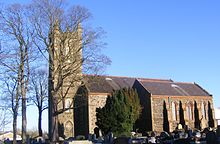St. Gobban
|
Saint Gobhan of Seagoe |
|
|---|---|
| Gobban Find mac Lugdach | |

Church of St Gobhan
|
|
| Personal details | |
| Born | 6th century |
| Died | 639 |
| Buried | Clonenagh/Laois or Clooneagh/Kerry |
| Sainthood | |
| Feast day | 6 December |
St Gobhan has long been historically linked with the parish of Seagoe – Teach dho-Ghobha in County Armagh, Ireland. A St Gobban - Gobban find mac Lugdach (c. 560-639), was primarily known for his abbacy of the monastery of Oldleighlin, County Carlow, where in 633 an important synod was held to debate the timing of Easter. This monastery later evolved into St Laserian's Cathedral, Old Leighlin. St. Gobban also held authority at Killamery – Cell Lamraide in county Kilkenny. St Gobban died in 639 and was buried in either the ancient abbey of Clonenagh: Cluain-Ednech, County Laois or Clooneagh: Chluain Each, County Kerry.
Clans, landscapes and borders
A holy man named St. Gobhan-(St Goban-Gobban-Goba) is associated with the foundation c. 600, of a church of Celtic Christianity origins in the parish of Seagoe, Portadown, County Armagh, Northern Ireland. The present St. Gobhan's church is a post reformation Church of Ireland and is located within the Anglican Communion Diocese of Down and Dromore or alternatively the Roman Catholic Church Diocese of Dromore. The 17th century Irish historian and hagiographer John Colgan wrote of this location: "Gobanus – Goba of Teg da-goba – Seagoe, on the bank of the Bann in Iveagh of Ulidia (also) St. Gobanus of Killamery, near the mountain called Slievenaman."
Situated four miles due south of Lough Neagh, St. Gobhan's church stands on a high-commanding ridge overlooking and to the east of the upper river Bann in a region where three counties almost meet – County Armagh, County Down and County Antrim. When St. Gobhan first arrived in this locale almost one and a half thousand years ago he was in the lands of the Uí Echach Cobo whose territory would later become the baronies of Upper & Lower Iveagh,in modern day County Down.
...
Wikipedia
